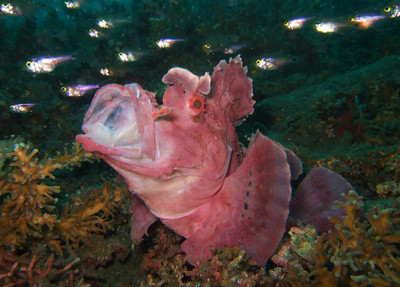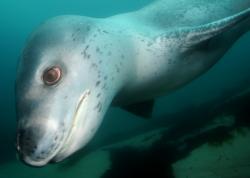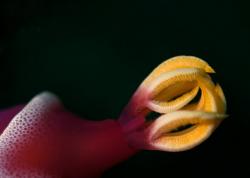Introduction
Introduction to Underwater Photography
Welcome to the wonderful world of underwater photography. I wrote this guide hoping that others can share my love of capturing the beauty of the underwater world. Although we all may have slightly different interests underwater, I am sure we all share a common bond of wanting to take great photographs underwater.
Modern technology has greatly changed our view of underwater photography. Cameras are much easier to use and housing manufacturers have given us a sometimes bewildering array of options. While this guide focuses solely on digital technology, the fundamentals remain. Finding the right subject. Capturing the right moment. Presenting it in the right fashion. The new technology makes it a little easier, and a little more accessible.
Seahorses, octopus, colorful sea slugs. Giant Groupers getting cleaned. Beautiful Leafy Sea Dragons. Huge mantas soaring overhead. The marine life underwater is amazing! I am a lover of nature and nature photography, and nowhere have I found more prolific or accessible nature than underwater. I hope all of you can feel the same pleasure I feel when I break the surface of the water and find myself surrounded by new and familiar species. With today’s digital cameras, anyone can afford to capture what they see underwater and share it with their family and friends. So what are you waiting for? - Scott Gietler, 2009
Are you an absolute beginner at underwater photography?
You might want to read our underwater photography guide for beginners
Is this guide for compact camera or dSLR users?
Most of what is written here applies equally to compact cameras and dSLR camera users. Most compact cameras suitable for underwater use will work with a strobe, take add-on macro and WA lenses, and allow some control of shutter speed and/or aperture.
How to use the Underwater Photography Guide
UWPG is a vast resource for improving your underwater photography, whether taking a camera into the water for the first time or a seasoned veteran looking for inspiration.
Use the column on the left to navigate through the chapter you're interested in. We've also placed links throughout each page, suggesting further reading or to address in detail something we mention in the article. Easy as that.
Introducing the SMP system
What makes a good photo? Everyone has his or her own definition. I like to concentrate on my own criteria that I've developed, called subject, moment, presentation, or SMP for short. Many great shots have a well-chosen subject, and they perfectly capture the moment, the presentation, or both.
Subject
- What subject was captured in this photo? Is it a shark, a school of fish, a reef, a kelp forest? What is the background? The background is also part of composition. What colors are being displayed? Some people like to choose subjects with bright colors, such as red or yellow.
- Your dive destination, your depth and the time of day will dictate your subject choices. Some people prefer their own backyards, some people fly to exotic locations. Regardless, if you don't get in the water, you won't accomplish step #1, choosing your subject.
Moment
- What moment was captured? Was the subject feeding, sleeping, mating, fighting, or swimming? Facing the camera? Or was a sense of peacefulness captured?
- After choosing your subject, you must wait for the right moment. It could involve waiting for the subject to feed, or it could involve waiting for an ideal composition.
- You want to choose the moment at which your subject looks its best. It could be a frogfish with its mouth open, a goby with its fins up, or a squid with its tentacles apart. Watch your subject for a while to see its different poses, expressions, and antics.
Presentation
- Now that you have a subject, and you've chosen the moment, you will use your equipment to make a presentation.
- Fill the frame? Backlight the subject? Create a small depth of field?
- Sharpness is also an important part of presentation, especially for the main subject and the eyes of the subject.
- Where is the focal point? Did your focal point give you the effect you wanted?
- Composition, lighting, focus, technical detail
It's important to note that you don't need the most expensive camera gear to make a great shot. The S (subject) and M (moment) in SMP is independent of camera gear. So is a good amount of composition. If your camera has minimal shutter lag, and focus capability, and you have the proper lighting, usually at least 1 strobe, sometimes 2, you can take a great shot. The only caveat I'll add is that some presentations that you imagine will need a macro or fisheye lens, which are available with most camera systems, even for many compact cameras.
Is it the photographer or the camera?
"Great photos, you must have a nice camera!" Many photographers have heard that line. Underwater photography is definitely gear intensive. I have seen great underwater photos from fairly inexpensive gear. I've also seen very bad photos from expensive gear. I feel than anyone with a point & shoot, or any dSLR, can create a great photo if they have the right lens and the right lighting.

Rhinopia, photo taken by Penelope Foo, Fuji F10, automatic mode, internal flash. Sometimes it's just the photographer!
Some of the gear listed below will definitely make the job easier. But the photographer still has to do the majority of the work. In the end, get the gear you need, buy the best you can based on your budget, and focus on the process of photography, the creative processes, and try not to focus on the gear. So how do you know what gear you need? I explain this in the next few sections on underwater photography equipment.

RECOMMENDED ARTICLES
SUPPORT THE UNDERWATER PHOTOGRAPHY GUIDE:
The Best Service & Prices on u/w Photo Gear
 Visit Bluewater Photo & Video for all your underwater photography and video gear. Click, or call the team at (310) 633-5052 for expert advice!
Visit Bluewater Photo & Video for all your underwater photography and video gear. Click, or call the team at (310) 633-5052 for expert advice!
The Best Pricing, Service & Expert Advice to Book your Dive Trips
 Bluewater Travel is your full-service scuba travel agency. Let our expert advisers plan and book your next dive vacation. Run by divers, for divers.
Bluewater Travel is your full-service scuba travel agency. Let our expert advisers plan and book your next dive vacation. Run by divers, for divers.





























